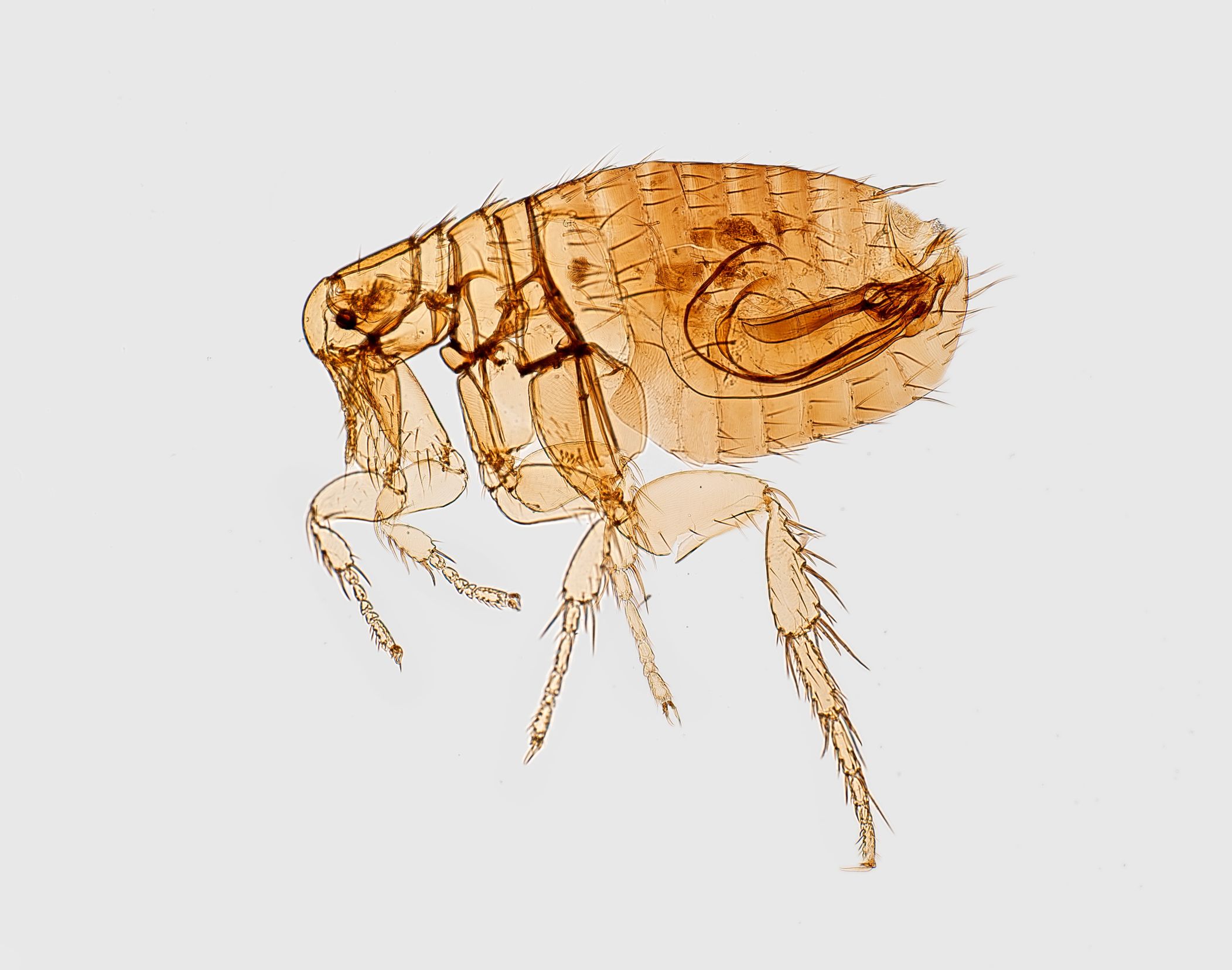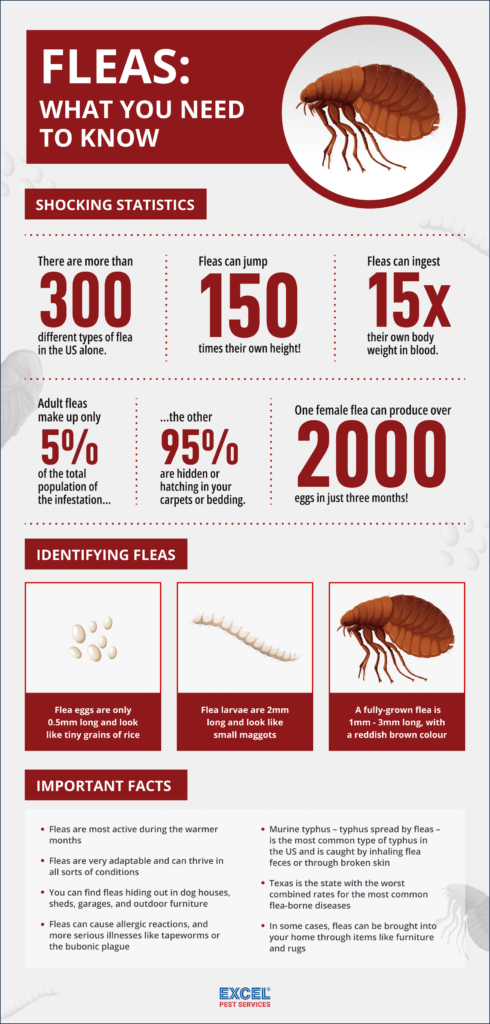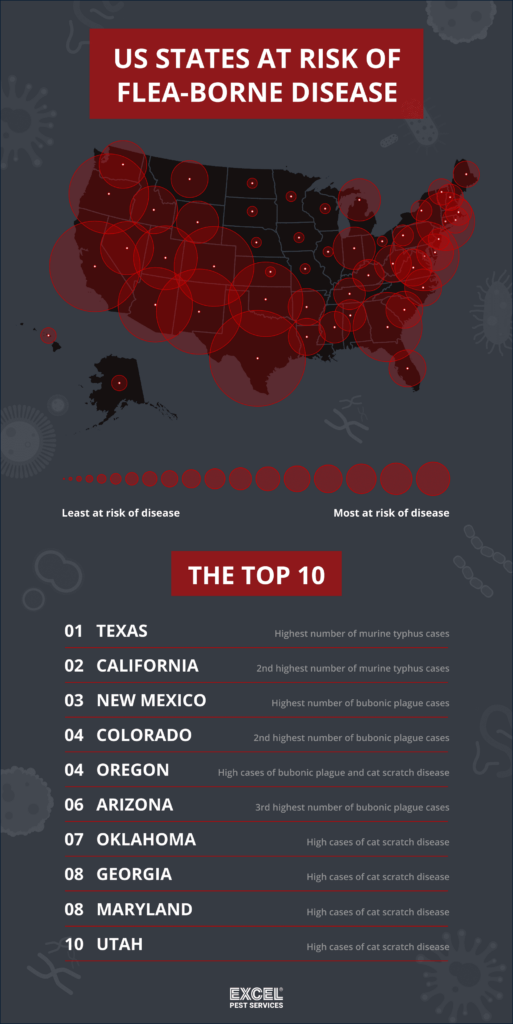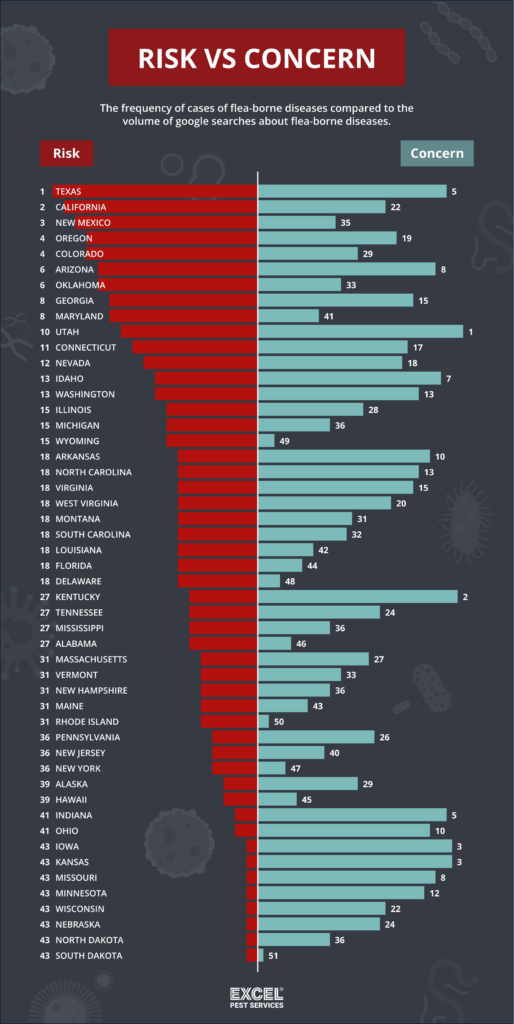

Our comprehensive guide condenses 30 years of experience to teach you everything you need to know to become (almost!) as much of a flea expert as we are.
Have a specific question? Use our helpful contents below to jump to the answer:
What happens if fleas are left untreated?
Why are fleas dangerous for pets?
Why are fleas dangerous for humans?
Do I have cat scratch disease?
Which US states have the highest rate of flea-borne diseases?
Which US states are most paranoid about flea-borne diseases?
Flea Bite and Infestation Prevention
What’s the best way to prevent a flea infestation?
I’ve only spotted a few fleas, it can’t be that bad.
How to spot a flea bite on your pet
How to spot a flea bite on humans
Flea Basics
What is a flea?
The Siphonaptera family, or fleas, is a type of flightless parasite which lives by ingesting the blood of its hosts. There are many types of fleas and there are more than 300 different types in the US alone.
What do fleas look like?
Adorable! Just kidding. Put a flea under a microscope and you will see a large avocado-shaped abdomen, with a tiny head and six legs with the two longest legs dangling at the back (hairy, strong, and ready to propel that tiny flea higher than 150 times their own height!). Instead of teeth, fleas have a needle-like mouth which they use to pierce the skin of their hosts. Their flat bodies help them navigate through fur and hair with ease.
When are fleas active?
Fleas are most active during the warmer months, which means in some states (like Florida) flea season lasts all year round whereas in others (like New Jersey), flea season typically lasts between March and December. Unless they have the body heat of a host to keep them warm, fleas die out in the cold.
What attracts fleas?
Fleas have developed lots of tools to make themselves experts at hunting down hosts. Fleas are finely attuned to sense vibrations, movement, and the body heat of a nearby animal. They can even be sensitive to the CO2 levels in the air to tell if a live animal is nearby.
One urban myth is that fleas are attracted and repulsed by many different scents. Actually, there is only one scent that is proven to attract fleas: the natural scent of its victims.
Where can I find fleas?
Although a flea’s favorite climate is humid and shady, fleas are very adaptable and can thrive in all sorts of conditions. When outside, fleas seek out homes with lots of nooks and crannies – like debris piles and shrubs. In residential areas, you can find fleas hiding out in dog houses, sheds, garages, and outdoor furniture.
When a pet is infected, although the adult flea will latch onto the coat of the animal, flea eggs will often roll off onto the floor. This means that you can typically find flea eggs in areas that your pet frequents (like in their bedding, carpets, or chairs). Further on in the flea cycle, after the eggs the female fleas have laid have cracked, the larvae and pupae (a dark, tough cocoon) can be found buried in cracks, crevices, and soft furnishings.
Fleas in New Jersey
In New Jersey the most common kind of flea is the cat flea. Don’t let the name fool you, these reddish brown fleas aren’t picky about which kind of pet they infect. The peak period in New Jersey for fleas are the spring and summer periods, kicking off in April and petering out by December.
Fleas in Florida
As in New Jersey, the most common flea in Florida is the cat flea although a few dog fleas have also been found in the state. Floridians may be blessed with one of the warmest climates in the US, but unfortunately, it’s not just humans who find these warmer temperatures attractive. Floridians need to be vigilant all year round for signs of fleas and flea infestations.

What happens if fleas are left untreated?
If the itching and scratching don’t drive you (or your pets) wild, then why is having a flea infestation a cause for such concern?
First off, you may not find the mild infestation annoying now, and think that the problem can wait, but that tiny flea problem can very quickly get out of hand – one female flea can produce over 2,000 eggs in just three months!
Fleas can cause all manner of problems for you and your pets – ranging from annoyance to allergic reactions to contracting serious illnesses like tapeworms or the bubonic plague (more on that below).
Why are fleas dangerous for pets?
Fleas cause both internal and external issues for pets. Dogs and cats can scratch and itch so much that the skin breaks and becomes infected, causing painful scabs and hair loss.
Worse than that, fleas can cause nasty internal issues for your furry companions too. Ingesting a flea can cause tapeworms, a parasite that lives and feeds in the intestine. Tell-tale signs that your dog has tapeworms is if they drag their bottom along the floor and in serious cases, weight loss. Luckily, tapeworms can be treated with a variety of medications but it’s important that fleas are eradicated to prevent re-infection.
A flea infestation can also be particularly rough for puppies, kittens, or small pets as fleas can ingest 15 times their own body weight in blood. This means that smaller pets are at risk of developing anemia from blood loss, leaving them weak and susceptible to more serious illnesses.
Why are fleas dangerous for humans?
In most cases, flea symptoms are limited in humans to a really irritating itch that goes away on its own. But for those with allergies or impaired immune systems, you might blister or develop hives or a rash. In rare cases, humans can also contract tapeworms from ingesting fleas.
If you scratch the area and break your skin, you also put yourself at risk and some serious diseases. The most common flea-borne diseases in the United States are the plague, flea-borne typhus, and cat scratch disease. Although cases of these serious diseases are rare, unfortunately, due to rising temperatures and the growth of international travel, experts warn that we need to be wary of these dangerous pathogens.

Flea Borne Diseases
What is the bubonic plague?
When you think of the plague, you probably think of the medieval epidemic the ‘Black Death’. But the plague doesn’t just exist in the history books, it still exists in the US today. In the US the most common form of plague is the bubonic plague which is carried through fleas. Cases most frequently occur in rural areas where the disease is circulated by rodents like squirrels and rats.
Do I have the bubonic plague?
If you are worried you have the plague, then first off check for signs of fleas and flea bites (and use our guide to help). Next, check your groin, armpit, or neck for a swollen, painful lymph node. As with most serious diseases, other typical symptoms include fever, chills, headache, and fatigue.
Back in the 14th century, contracting the bubonic plague was a sure death sentence. Today, thanks to medical advancements, the plague can be successfully treated through antibiotics.
What is murine typhus?
There are a few types of Typhus, some spread by louse, mites, or ticks, but murine typhus – typhus spread by fleas – is the most common type of typhus in the US and is caught by inhaling flea feces or through broken skin (like scratching your flea bites).
Luckily, typhus is incredibly rare in the US and isolated mainly to a few states (California and New Mexico particularly). However, visitors arriving from tropical or subtropical destinations can carry the disease, so if you are planning a trip abroad, make sure to check out the prevalence of the disease in the area and take necessary precautions.
Do I have murine typhus?
If you do detect fleas or flea bites on your body and are experiencing headaches, fever, aches, pains, and nausea, you should make an appointment with a healthcare provider as soon as possible. Almost half of those infected develop a rash around six days after the onset of symptoms and almost half will also suffer neurological symptoms like confusion or issues with balance.
Again, murine typhus isn’t the death sentence it used to be, and if given antibiotics promptly most people make a quick recovery.
What is cat scratch disease?
The aptly named cat scratch disease (or CSD) is an infectious disease carried in cats who have caught the disease from fleas. An infected cat can transmit this disease to humans either through a scratch, bite or by licking an open wound.
Do I have cat scratch disease?
The most common indicators of infection are that the scratch becomes red and swollen, followed by flu-like symptoms, a body rash, and swollen glands. If you have been scratched on the arm or hand then you are more likely to find swollen glands under the armpit, and if you’ve been scratched on the foot or leg you are more likely to have swollen glands around the groin.
For most healthy people, CSD doesn’t cause major health problems, but for small children and those with suppressed immune systems, one small scratch can have big consequences. In rare cases, CSD can lead to issues with your eyes, brain, and internal organs. Luckily, if your symptoms haven’t passed in a couple of months, your healthcare provider can provide antibiotics to clear up the infection.
Which US states have the highest rate of flea-borne diseases?*
So the research shows that although rare, we should be taking cases of flea-borne diseases seriously. But who is most concerned (and who really should be) when it comes to flea-borne illnesses in the US? We analyzed the most recent state-level health statistics and google searches for cat scratch disease, typhus, and the plague to find out.
Texas is the state with the worst combined rates for the most common flea-borne diseases, coming top for cat scratch disease and typhus and 7th for incidents of plague. Californians are next most likely to contract one of these flea-borne diseases, ranking 2nd for typhus, 4th for plague, and 5th for cat scratch disease. Completing the top three, and ranking worst for the plague is New Mexico which also ranked 3rd for typhus cases and 8th for cat-scratch diseases.
Which US states are most paranoid about flea-borne diseases?*
But despite cause for concern, it wasn’t these states which were most paranoid about these flea-borne diseases. Utah, Kentucky, and Iowa were the most likely to search about symptoms of Typhus, Plague, and Cat scratch disease (despite Utah placing 10th, Kentucky placing 27th and Iowa 43rd for the number of incidents!)

Flea Bite and Infestation Prevention
Why do I have a flea problem?
Even if you are vigilant about fleas and have high standards of cleanliness, it just takes one or two of these critters being carried into your home to cause mayhem, thanks to their super-charged breeding rate.
If you have multiple pets, then fleas can jump easily from one host to another until all household pets are infected. And you don’t even need to have pets to have a home infestation. In some cases, fleas can be brought into your home through items like furniture and rugs.
What’s the best way to prevent a flea infestation?
One of the best habits for flea prevention is to comb through your pet’s hair before they return inside. Wash both your and your pet's bedding regularly and if your pet has long hair, you might want to consider trimming it to make flea detection easier and transmission less likely.
Other robust measures include flea collars and applying a regular flea and tick prevention product like a spray, shampoo, or medication under the guidance of a veterinarian.
How to spot fleas
Without a microscope, it isn’t impossible to detect fleas, but it is very hard. A fully-grown flea is between 1mm to 3mm long and typically has a shiny, reddish brown exterior. Considering their size, It’s not uncommon to have a flea infestation and not even realize it. Luckily, there are some things to be on the lookout for.
Adult fleas are fast, tiny, and easy to miss, in fact, it’s easiest to spot a flea with the naked eye when it’s just hatched. Flea larvae look like small 2mm long maggots however they like to burrow into crevices like carpets, cracks, and grass.
Another sign of fleas and flea infestations is by spotting flea eggs and flea dirt. Flea eggs are only half an mm long and look like tiny grains of rice whereas flea dirt looks like tiny dark specks.
You’re probably not going to spot a singular egg or flea dropping, but if your dog, pet’s bedding, floor, or surfaces look like they’ve been liberally seasoned with salt and pepper, then it’s worth investigating. If you suspect the fine, white specks to be flea eggs, place them on a dark piece of paper and use a magnifying glass to identify the classic oval shape of a flea egg.
I’ve only spotted a few fleas, it can’t be that bad.
So you’ve spotted a couple of fleas on your pet, but your pet isn’t crawling with them – so the problem can’t be that bad, right?
Adult fleas make up only 5% of the total population of the infestation, the other 95% are writhing around or hatching in your carpets or bedding. To make matters worse, within a day of infesting your pooch or cat, female fleas can lay up to 50 eggs! Therefore it’s super important to act as soon as you detect fleas.
How to spot a flea bite on your pet
Flea bites are harder to spot on our more hairy companions. Depending on the fur color of your pet, a good combing or rummaging session might be enough to identify fleas or flea eggs.
But the easiest way to assess whether your pet has fleas is to check their symptoms. If your cat or dog has fleas they will be scratching. When irritated, they might even be biting and chewing at their skin, and have hair loss or scabs.
How to spot a flea bite on humans
1. Check your legs and ankles for bites
The most common areas that humans are bitten are the feet, legs, and ankles. This is because these areas are the easiest for fleas to reach from the ground.
2. Look for patterns
Unlike with mosquito bites where there are fewer big bites, flea bites are typically small and clustered. You also might notice a discolored ring around the bite. One more unique indicator to detect fleas is that unlike other insect bites, flea bites don’t typically swell.
3. Check your symptoms
The most common symptoms of a flea bite are itchiness and skin irritation but in more complicated cases, like cases of infection, flea bites can cause flu-like symptoms to develop and rashes. To avoid an infection, it is very important not to scratch and break your skin.
How do I get rid of fleas?
- Clean every flea hotspot in your home. This includes washing your bedding, your pets bedding and soft furnishings, vacuuming, and paying extra special attention to cleaning carpets and edges of walls. It’s important to note that fleas can’t live long in a vacuum bag due to the lack of oxygen, however, it can take up to five days for them to suffocate.
- Treat your pets for fleas. Bathe and comb your pets and pay close attention to the area around the tail, the next, and face. Using soap will help kill fleas but make sure to also apply a flea treatment product for peace of mind.
- Pest control. You need to begin home treatment at the same time you treat your pets to make sure you get ahead of the flea cycle. At Excel, we use an (IPM) approach, addressing the cause of pest problems at the source. IIPM is a proven, cost-effective strategy to combat pest problems without unnecessary pesticide use and coordinates the use of pest biology, environmental information, and available technology.
- follow-up treatments. Fleas are stubborn and have evolved to become resistant to insecticides and flea control products at different stages of their life cycle. This means it’s vital to rinse and repeat flea treatment and to continue with high standards of cleanliness.
If you are a New Jersey or Floridian homeowner dealing with a flea infestation, we're here to help. Contact Excel Pest Services today for effective solutions in both commercial pest control services and residential pest control to eliminate flea infestations.
*Methodology
Google trends data of search volume between Feb 2023 - Feb 2022 for:
- Plague symptoms*
- Typhus
- Cat scratch disease
(Suffix ‘symptoms’ added to filter out searches for related video game searches)
Cat scratch disease 2005-2013
Organized by division: https://wwwnc.cdc.gov/eid/article/22/10/16-0115-f2
Plague cases 1970-2020
Typhus cases in 2019
Typhus cases were sourced from a variety of state-level departments:






